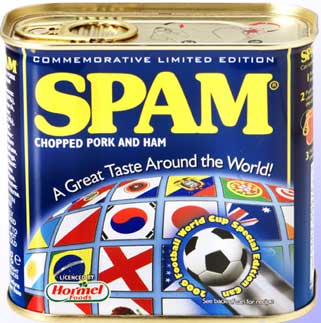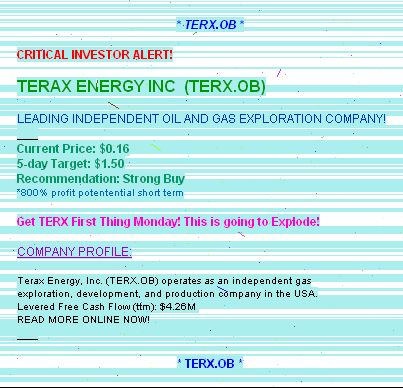 |
||||
|
|
My Writing |
|||
|
From the January 2007 Rich by Thirty Newsletter
Spam ‘n’ Eggs Noted value investor John Price (Sherlock Investing) advises his readers to avoid being anti-investors. You know – the guy who buys a stock based on a hot tip from the guy at the gym, the mailman, his barber, or his auntie. Other hot tips to avoid are those annoying spam emails touting this or that stock. Unfortunately, such spam emails are everywhere and there is little you can do to avoid them. According to an October article at Bizreport.com, stock spam makes up 15% of all spam sent, up from just one percent a year and a half before. Typically these emails will tout a stock on the U.S. Over-the-Counter Bulletin Board or OTCBB. And typically such stocks are unproven and speculative penny stocks. There are some quality issues on the OTCBB. Samsung, the giant Korean electronics conglomerate, for example, trades on the bulletin board. But the vast majority are high risk speculative ventures and the wise investor won’t touch them with a ten foot pole. The emails promoting such penny stocks are often part of an illegal scheme known as pump and dump. Insiders to the scheme buy the stock and then promote it like crazy, often with spam emails but also by adding promotional messages to stock market discussion websites such as Raging Bull or Silicon Investor. Some go so far as operating boiler rooms. Investopedia defines a boiler room as “a place where high-pressure salespeople use banks of telephones to call lists of potential investors (known as "sucker lists") in order to peddle speculative, even fraudulent, securities. A boiler room is called as such because of the high-pressure selling. “ Investopedia goes on to note that such operations discourage outside research into a stock and use catchphrases such as “it’s a sure thing” or “opportunities like this happen once in a lifetime.” Not surprisingly, these are the same sort of catchphrases used in spam emails promoting such stocks. Going through a few you find lines like “this one is going to go through the roof” or “it’s going to explode” or ”watch it soar beyond your wildest dreams”. Once these operators have “pumped” up the stock price through their hype, they then “dump” the stock, collecting a quick profit. The stock then collapses as everyone rushes to get out. The people sending out such spam are slippery as eels as well. They continually adjust their methods to avoid being caught by spam filters. Some spam filters delete messages with certain words or phrases but will allow such terms if the phrases are part of a larger message and so could be innocent. So the purveyors of spam started adding lines of gibberish that has nothing to do with the main message. The gibberish in the box below was copied from one such spam message. Sometimes they’ll copy and paste a paragraph or two from a book such as Lord of the Rings.
But spam filters managed to filter these as well and so they started using a picture of the message instead of typed text. The spam filters can’t read the message in the picture so the message gets through. The spam message on the right below is an image file copied from an actual spam email. All the words are included in a gif file. You can even see the imperfections of the paper from which the message was photocopied.
But, you might ask, are any of these recommendations ever good? Sure they’re spam, but maybe I can make a fortune buying one of these hot tips. Don’t count on it. There are a couple of websites that track stock market related spam and the track record ranges from poor to rotten. One, Spam Stock Trader, includes a list of 105 spam promoted stocks and how they have fared. Joshua Cyr, the creator of this site notes that on May 5, 2005 he “set out to determine just how much money I could lose by trusting SPAM”. He received 4272 spam emails touting 105 stocks or an average of 40 emails per stock over a period of four months. He expected to see temporary windfalls and then big losses. In fact, “almost ALL of those stocks went up a few cents max, then dropped like flies the next day.” How bad was it? Well, of the 105 stocks, only three went up. One stayed even. And 101 went down. Many were wiped right out. The average loss? An astounding 82.73%! Another fellow, Leonard Richardson, maintains an extensive log of stock spam received which includes copies of all the spams received each day and charts for each stock’s action on the day the spam was sent. You’ll find it at http://www.crummy.com/features/StockSpam/ Check out the archive for the complete list. Richardson links to two academic studies which point out that these schemes do work for the people operating them. The stocks usually do go up an average of 5% before crashing. But unless you’re an insider to the scheme, timing it is next to impossible. And the risk is huge. On a final note, a reader of Rich by Thirty complained to us about receiving stock related spam. She believed the spam originated with us. Let me assure our readers that we do not send out spam emails nor do we sell or rent our mailing list to others. There have been instances of spammers using trojans to hijack other people’s mailing lists and send spam that is supposedly from the hijacked person. I use highly regarded and current anti-virus software that also guards against our list being hijacked. If you receive spam email, it did not originate from us. If you are ever in doubt and believe you did receive spam somehow connected to us, please forward it to me at marco@breakoutreport.com and I will check it out. |
|
|||
|
|
||||
|
Contents copyright ©
Marco den Ouden All Rights reserved |
||||
|
|
||||















